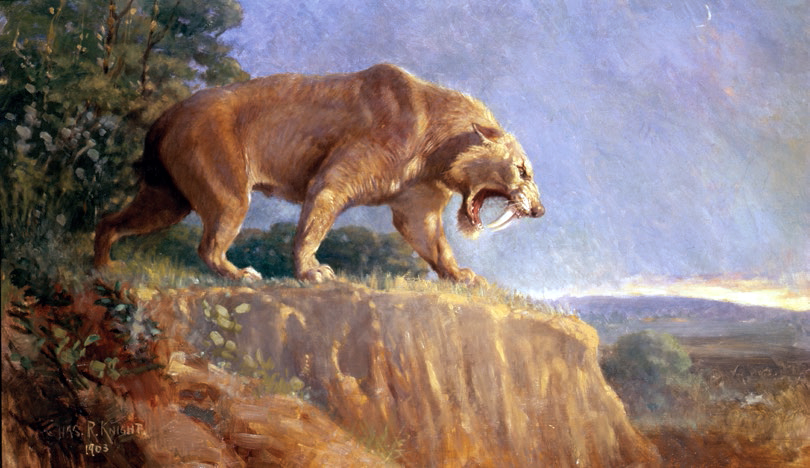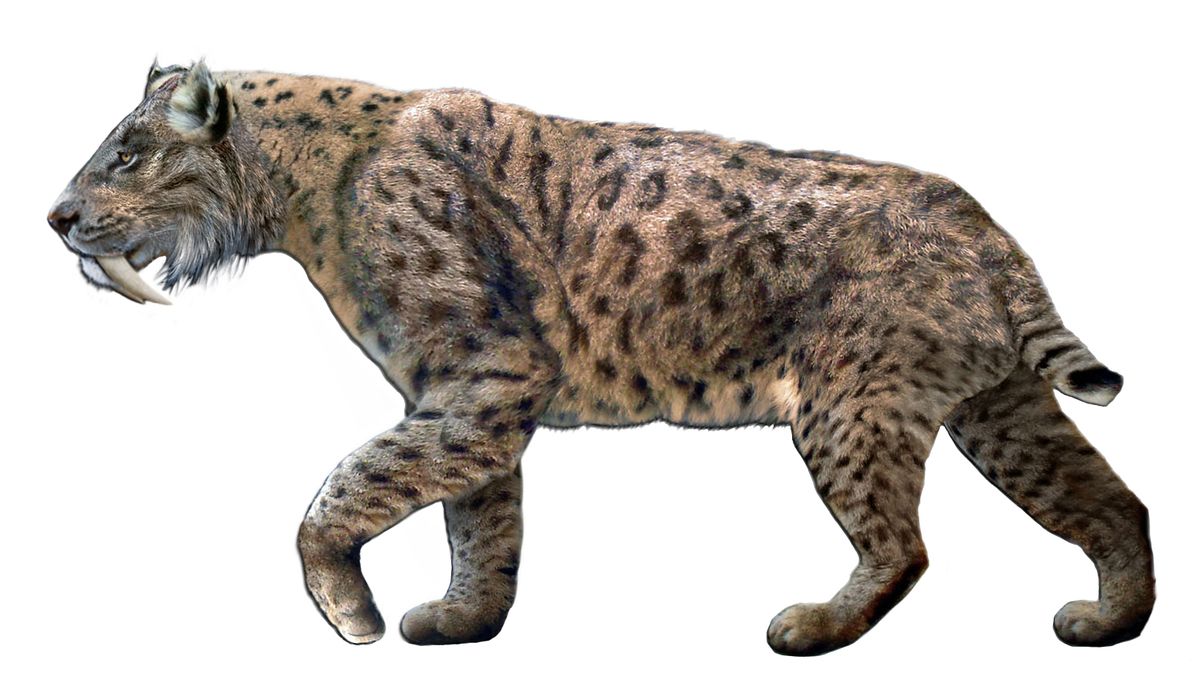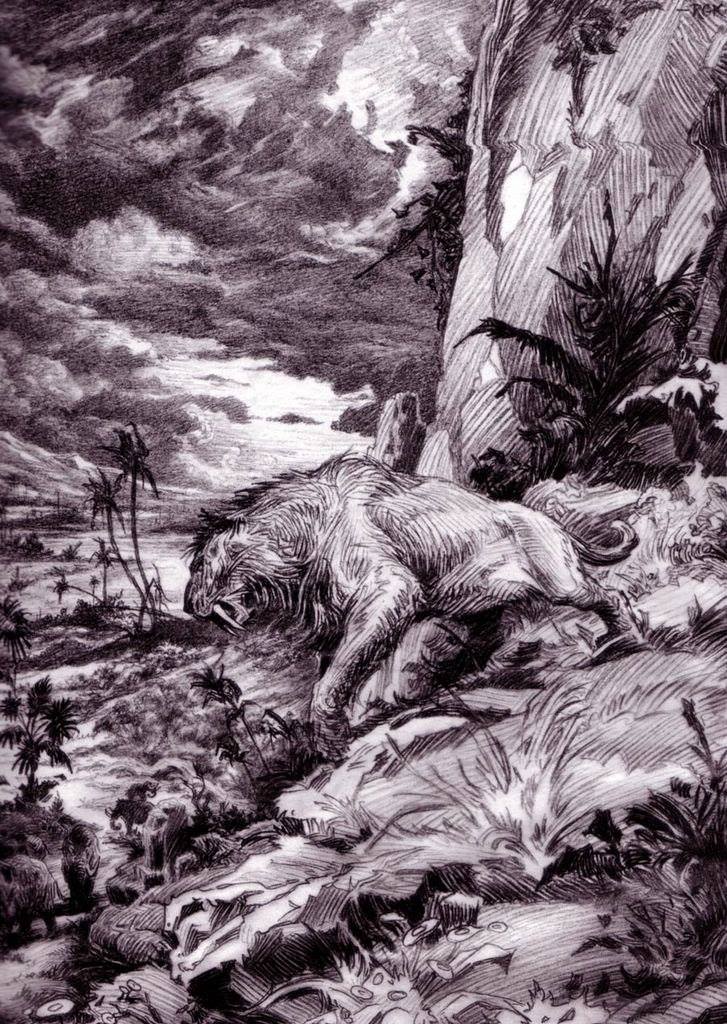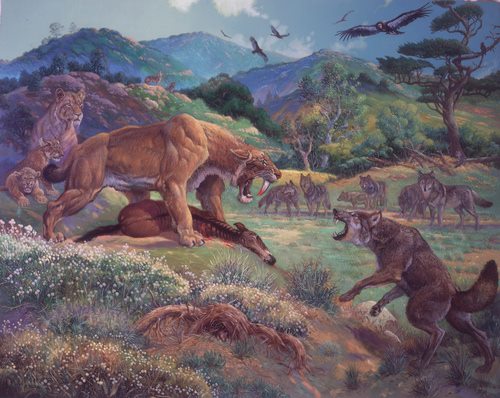Robert E. Howard’s Prehistoric Beasts: Saber-Tooth Tiger
Sunday , 18, August 2024 Uncategorized 1 Comment Robert E. Howard made reference to lions and tigers quite a bit in his fiction comparing characteristics of his heroes to the big cats. He also used the prehistoric saber-tooth tiger a few times.
Robert E. Howard made reference to lions and tigers quite a bit in his fiction comparing characteristics of his heroes to the big cats. He also used the prehistoric saber-tooth tiger a few times.
Saber-tooth cats are a sub-family (Machairodontinae) of the Felidae (true cat) family. Mammals have put out saber toothed predators in the past 50 millions years. A Creodont (Machaeroides) from a meat eating order that predominated from the Eocene to the mid-Miocene; the Nimravids, cat like carnivores from the mid-Eocene to the late Miocene; the Barbourofelids; the Thylacosmilus, a saber-tooth marsupial found in South America, and the Machairodontinae.
The Machairodontinae originated in Africa in the early or middle Miocene. They radiated out to other continents and grew in size to take advantage of the megafauna as the world got colder. In popular culture, Smilodon fatalis due skeletal remains from the La Brea tar pits is the best-known saber tooth tiger. It is probably the one that Robert E. Howard knew. Smilodons evolved in North America probably from a Megantereon species that entered North America in the Pliocene. From Megantereon, Smilodon gracilis evolved 2.5 million years ago, lasting for around 2 million years. Smilodon fatalis existed 1 million to 10,000 years ago. It was found in North America and western South America. A sister species, Smilodon populator was found in eastern South America. At the same time, Homotherium, another genus of saber-tooth cats spread from Africa to Eurasia, crossing into North America and south to what is now Venezuela.
Smilodon fatalis weighed 350-620 lbs, had a shoulder height of 39 inches, and length of 69 inches. Smilodon populator ranged up to 880 lbs! It is the largest known feline. The Smilodon species had the longest canine teeth, 11 inches long in Smilodon populator.
The various saber-tooth tiger species died out by 10,000 years ago.

Where did Robert E. Howard learn about the saber-tooth tiger? A black & white reprint of Charles R. Knight’s classic Smilodon painting was included in H. G. Wells’ The Outline of History with the caption “This savage beast roamed South America and California, as well as Europe, during the Glacial Period.”
In fiction, Edgar Rice Burroughs liked the saber-tooth tiger as it turned up in the Caspak novellas, The Eternal Lover, and most importantly in At the Earth’s Core, a book in Robert E. Howard’s library.
Howard probably read Paul L. Anderson’s tales of cavemen, the Ta-an in Argosy in 1920 but there is no mention of saber-tooth tigers in that series. The series has a lack of Pleistocene mega-fauna in general. Anderson did have a saber-tooth tiger vs. Mammoth in “The Asphalt Pool” (Adventure, April 20, 1922) that Howard probably read. Howard probably read C. M. Eddy, Jr.’s “With Weapons of Stone” (Weird Tales, Dec. 1924), which has an appearance of a saber-tooth tiger.
Howard offered to send A. Merritt’s “Dwellers in the Mirage” from Argosy in 1932. If he paid attention to Argosy through 1932, he would have come across “Helgvor of the Blue River” by J. H. Rosny Aine, translated by Georges Surdez that ran as a four part serial 5-28-32 to 6-18-32. Rosny wrote the best caveman novels. He has the wonder of all the Pleistocene mega-fauna of Europe including the saber-tooth tiger in this novel.
Robert E. Howard wrote his own Ta-an stories based on Paul L. Anderson’s Ta-an stories from Argosy. The “cruel sabertooth,” Sa-go-na is mentioned in the Untitled and Unfinished Ta-an fragment sometime in the early 1920s.
The saber-tooth tiger returned in the James Allison series.
“There were cave-bears, saber-toothed tigers, giant buffalo and elks, panthers.” – “Brachan the Kelt.”
“The Valley of the Worm” (Weird Tales, Feb. 1934) has the saber-tooth tiger as foe of Niord.
“One I killed, with the iron sword I had forged with my own hands, that most terrible of all beasts- old saber-tooth, which today call a tiger because he was more like a tiger than anything else. In reality he was almost as like a bear in build, save for his unmistakably feline head. Saber-tooth was massive-limed, with a low-hung, great, heavy body, and he vanished from the earth because he was too terrible a fighter, even for that grim age.”
Howard would bring the saber-tooth tiger front and center in “Beyond the Black River” (Weird Tales, May-June 1935).
“The creature that stood in the gate was like the embodiment of nightmare legend. Its color was of a curious pale quality which made it seem ghostly and unreal in the dim light. But there was nothing unreal about the low-hung savage head, and the great curved fangs that glistened in the firelight. It was survival of an older, grimmer aga, the ogre of many an ancient legend – a saber-tooth tiger. No Hyborian hunter had looked upon one of those primordial brutes for centuries.”
Howard gives a fair amount of space to the appearance of the saber-tooth tiger. Even Conan did not take it on.
The saber-tooth is gone from Hyborian lands but hanging on in the Pictish wilderness. Howard’s description is of a Smilodon though they were found only in North and South America. The saber-tooth tiger in “Beyond the Black River” is more likely a Homotherium, the scimitar toothed cat.

Saber-tooth tigers appeared to have rebounded after the end of the Hyborian Age and expanded their range. That is assuming the James Allison stories are in the same universe as Conan. There are some contradictions in the stories.
Almuric is a planet with fauna similar to Earth’s Pleistocene epoch. Esau Cairn mentions hyenas, “monstrous bears,” “gigantic boars” and the “sabertooth leopards, longer and heavier than an Earthly tiger and more ferocious.”
Large, robust saber-tooth cats impressed Robert E. Howard. Howard followed the ideas that saber-tooth were a “freak of carnivorous development, evolution run amuck.” They were impressive apex predators and a result of their environment. They were not freaks as saber-tooth predators keep re-appearing over millions of years.

[…] © Castalia House […]